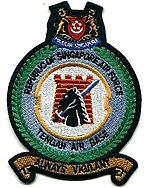Tengah Airbase
|
Tengah Air Base (TAB) Pangkalan Udara Tengah 登加空军基地 (Dēng Jiā Kōngjūn Jīdì) தெங்கா வான்படைத் தளம் (Teṅkā Vāṉpaṭait Taḷam) |
|||||||||||||||||||
|---|---|---|---|---|---|---|---|---|---|---|---|---|---|---|---|---|---|---|---|

Tengah Air Base Station Badge
|
|||||||||||||||||||
| Summary | |||||||||||||||||||
| Airport type | Military airbase Airfield | ||||||||||||||||||
| Owner | Ministry of Defence (Singapore) | ||||||||||||||||||
| Operator | Republic of Singapore Air Force | ||||||||||||||||||
| Location | Western Water Catchment, Singapore | ||||||||||||||||||
| Elevation AMSL | 15 m / 50 ft | ||||||||||||||||||
| Coordinates | 01°23′14″N 103°42′31″E / 1.38722°N 103.70861°E | ||||||||||||||||||
| Runways | |||||||||||||||||||
|
|||||||||||||||||||
Tengah Air Base (IATA: TGA, ICAO: WSAT) is a military airbase of the Republic of Singapore Air Force located in the Western Water Catchment, in the western part of Singapore. The station is the most important airfield of the RSAF as it houses the majority of the RSAF's fixed-wing frontline squadrons, home to all of RSAF's Airborne early warning and control (AEWC) assets, most of the F-16C/D Fighting Falcons and a large number of UAVs. The airfield goes by the motto of "Always Vigilant", which is supported by its main motif, a chess board Black Knight piece symbolising the aircraft's operational readiness in Tengah. The sword represents war's heraldic sword of destruction, while the state is depicted by the castle.
Prior to Singapore's independence, it was a flying Royal Air Force station known as RAF Tengah.
RAF Tengah was opened in 1939. Tengah airfield was the target of carpet bombing when 17 Japanese Navy bombers conducted the first air raid on Singapore, shortly after the Battle of Malaya began. It was also the first airfield to be captured when Japanese forces invaded Singapore.
After the Japanese capture of Singapore, Tengah came under the control of the Imperial Japanese Army Air Force while the Imperial Japanese Navy Air Service took over the other two RAF stations of Sembawang Air Base and RAF Seletar as Singapore was split into north-south sphere of control. This effectively ensured that the Japanese Army took control of the south, including the administrative hub and population center of Singapore City, while the Japanese Navy took command of the north, which included the Royal Navy dockyard at Sembawang.
...
Wikipedia
